NATURALIST’S NOTEBOOK 18 TO 24 APRIL 2009
April 18 is cloudy and gray and we hope as we head out of the harbor that it will clear. Today the harbor is dotted with with eider ducks–ducks that spend almost all of their lives on or in the water. They feed primarily during the day, and at low tide, avoiding strong winds and large waves in Provincetown’s protected harbor. They dive well below the surface and use their wings to swim under water feeding on crabs, snails, mussels, clams, starfish, sea urchins and other small marine life. The common eider male’s color pattern is the reverse of most aquatic birds–with black bellies and white backs. The females are mottled brown, well camouflaged against their seaweed nesting habitat. Our destination is Cape Cod Bay where we have had incredible sightings of both baleen and toothed whales over the last week. Our first sighting is of 2 small humpback whales, Twister’s 2008 calf and an unknown. We see finback whales near the water’s surface. The Bay is teeming with microscopic plants called phytoplankton, a million of which are contained in one teaspoon of seawater. The ocean is a hidden garden of unknown proportion, its web of life complex. In its most simplified version, nutritent fertilizer give food energy to plants, which give food energy to animal plankton. The animal plankton give food energy to fish, other invertebrate life and right whales. Fish and certain other invertebrate marine life give food energy to whales and humans. The word plankton comes form the Greek world “planktos” which means “drifting“. Phytoplankton feed, directly or indirectly, all of the animals in the sea. As the base of the oceanic food web, they are the heartbeat of our oceans and provide atmospheric oxygen. Although invisible unless viewed under a microscope, we see their presence by the emerald green color of our ocean water. Further in teh Bay we spot four more small humpback whales (more unknowns of the year) and a large pod of Atlantic white-sided dolphins. In the afternoon the sun remains hidden and a large right whale is sighted closer to shore. We slowly move around this rare whale, complying with the Federal 500 yard distance rule. We see one finback whale in the distance and several small humpbacks. We identifiy Tapioca, Roswell’s calf of 2007 and Twister’s calf of 2008.
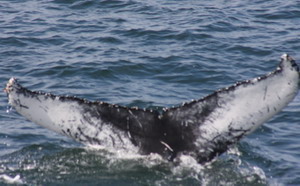
Roswell’s 2007 calf
On April 19 the morning is cloudy but gave way to sunshine by afternoon. We traveled into the Bay where we spotted several spouts of finback and humpback whales and the splashes of dolphins. Near Race Point we spotted a whale that seemed to be carrying fishing gear. It was in fact an entangled humpback whale and our capitan immediately called the Whale Resecue team at the Provicetown Center for Coastal Studies (PCCS) http://www.coastalstudies.org/what-we-do/whale-rescue/introduction.htm. Since 1984, PCCS has freed more than ninety large whales from life threatening entanglements, using techniques developed by Center staff. The Center is the only organization on the east coast of the United States federally authorized, by National Marine Fisheries Service, to disentangle large, free swimming whales, such as the humpback and the critically endangered North Atlantic right whale. Over the years PCCS has also disentangled other marine animals, like dolphins and porpoises, seals and sea turtles. The Dolphin VIII stands by the small entangled whale until the rescue team arrives. A few hours later, we learn that the wahle has been freed from all gear, a potentially life-threatening situtation. By afternoon it seemed as if the water was teeming with whales. We recorded eight humpback whales, 9 finback whales and over 400 white-sided dolphins! Gannets were plunge diving, one of the finbacks was lunging across the surface of the water, but the small humpback whales were spending most of their time below on long dives. Again the humpbacks were new to our catalogue and have been given numbers until next spring’s whale naming. All the while, the Pilgrim’s Monument in Provincetown loomed on the horizon. We were close to home.
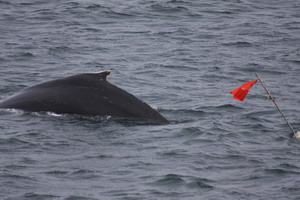
Entangled humpback whale
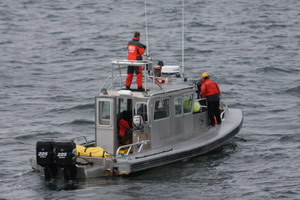
PCCS disentanglement team aboard R/V Ibis
20 April brought more clouds but relatively calm seas for spring. We ventured in the Bay towrads the west but the whales had moved0-as they often do in search of food. Our first sighting was of the smallest toothed whale in our waters, the harbor porpoise. The harbor porpoiseis a small, toothed whale reaching lengths of 6 feet (1.7 meters). It is inconspicuous and not likely to venture near the boat. With persistence from the naturalist and captain, we finally are able to see the small porpoise with its triangular dorsal fin and dark gray body. Unlike the dolphins, the porpoise rarely if ever bow rides and is seen in small groups of a few individuals. The porpoise feeds on small schooling fish such as herring that feed on zooplankton. Like most toothed whales, the porpoise grabs the fish with its teeth and swallows it whole. In the afternoon we return to Cape Cod Bay where several more whales are sighted; humpbacks, finbacks, a minke whale, harbor porpoise, white-sided dolphins and distance views of right whales. Humpbacks sighted included Eraser, Tapioca and Roswell’s 07 calf.
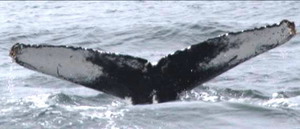
Eraser
No trips on 21 April due to stormy weather. Fog rolled in on the morning of 22 April but the seas were calm in Cape Cod Bay. We did not have to travel far to see our first whale- a small humpback close to Long Point. Just outside the Point we had close views of two large finback whales. All around the whales, gulls and gannets were soaring. Before long the fog lifted and we could see distant spouts of right whales deep in the Bay and humpbacks and finbacks near Race Point. Also near the Race was a small Minke whale, the smallest of the baleen whales in our waters and a whale still hunted today. While we waited for 2 small humpbacks to surface, a small harp seal approached the boat and stayed with us as we drifted for over 20 minutes! It was a treat for all on board, especially for a group of elementary school students. Although the harp seal is the most abundant seal in the Northern hemisphere, it is more commonly seen far to the North of Provincetown. Over the past few years, however sightings of young harp seals have become more common during springtime. By afternoon the sky becomes cloudy and rain and Northeasterly winds prevail. We make our way offshore to the southwest corner of Stellwagen Bank where we have been told there are feeding humpback whales. We leave Race Point and continue north, venturing into the North Atlantic to New England’s only Sanctuary- the Gerry Studds Stellwagen Bank National Marine Sanctuary. An ocean treasure, the sanctuary was designated by Congress in 1992 and is one of only 13 sites deemed to be of such special national significance. In these productive waters, a myriad of marine life lives, from the single-celled plankton to the great whales. Among its most well known species are humpback and right whales, northern lobsters, Atlantic cod and bluefin tuna. Approximately the size of the state of Rhode Island, the sanctuary includes the submerged lands of Stellwagen Bank, all of Tillie’s Bank and Basin, and the southern portions of Jeffrey’s Ledge. It rises up from depths of 600 feet (183 meters), leveling off at an average depth of 100 feet (30.5 meters) below the water’s surface. As we near the Bank we see several whales spouting and splashing. Twenty-two humpback whales, many of the actively feeding are sighted but in their midst are 2 North Atlantic right whales and we watch from a distance of over 500 yards. Many of the whales appear larger than those in the Bay and we see our first mother and calf- Reflection and her 2nd calf.
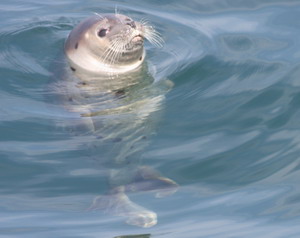
Harp seal
No whale watching on 23 April due to strong winds and rain. April 24 is bright and cold. In the Bay we sight several small humpback whales and 3 finback whales. Two of the humpbacks, Backgammon and Shoreline, were first sighted in 2007 and named this spring. Like most of the small whales sighted this year, they are not know calves of a previous year. At speeds of 10 knots we are not able to move out of the Bay in the morning due to an afternoon trip- but the sightings were numerous and included over 250 Atlantic white-sided dolphins. In the afternoon we venture out to Stellwagen Bank. Finback and humpback whales along with Atlantic white-sided dolphins are feeding in the rich waters of the bank. It is the dynamics between the physical and biological that vitalizes and maintains the Stellwagen system. Cold water constantly flows south from the Gulf of Maine distributing nutrients, plants and animals. Nutrients are also brought to the Bank by local currents that move east to west, driven by the tides. Underwater currents and tide form areas of upwelling as they are deflected off the walls of the Bank, bringing nutrient rich water to the surface. Microscopic plants multiply rapidly in the sunlit, nutrient rich waters, small animals rise from the depths to eat the plants, fish eat the tiny animals and in turn are eaten by other fish, seabirds and whales. Today there are no right whales in sight as we Nimbus, Division, Tornado and Tongs, all mature females, feeding. Also sighted were Grackle, Crystal, a male born to Salt in 1980 and Divisions calf of 2008. So ends another spectacular week of spring whale watching!
Birds sighted: Black-backed, herring, laughing and glaucous gulls; common loon; common eider; double-crested cormorant; white-winged scoter; Northern gannets; razorbills; black ducks; parasitic jaeger.





